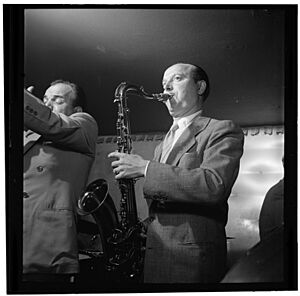Bud Freeman facts for kids
Quick facts for kids
Bud Freeman
|
|
|---|---|

Bud Freeman, New York City, 1947
|
|
| Background information | |
| Birth name | Lawrence Freeman |
| Born | April 13, 1906 Chicago, Illinois, U.S |
| Died | March 15, 1991 (aged 84) Chicago |
| Genres | Jazz |
| Occupation(s) | Musician |
| Instruments | Tenor saxophone, clarinet, C melody saxophone |
| Years active | 1920s – 1980s |
Lawrence "Bud" Freeman (born April 13, 1906 – died March 15, 1991) was an American jazz musician. He was also a bandleader and a composer. Bud Freeman was best known for playing the tenor saxophone. He also played the clarinet.
Contents
Discovering Jazz: Bud Freeman's Early Life
Bud Freeman was born in Chicago, Illinois. In 1922, when he was a teenager, he and some friends from high school started a band. They called themselves the Austin High School Gang. At first, Bud played the C melody saxophone. Other band members included Jimmy McPartland and Frank Teschemacher. Two years later, he switched to the tenor saxophone.
Inspired by Jazz Legends
The Austin High School Gang was greatly influenced by other jazz groups. They loved the New Orleans Rhythm Kings. They were also inspired by the famous musician Louis Armstrong. When Armstrong was playing with King Oliver's Creole Jazz Band, Bud Freeman and Jimmy McPartland went to their shows. They watched them perform at a place called Lincoln Gardens. Because they were always together, Bud and Jimmy were nicknamed "Alligators."
Bud Freeman's Musical Journey
In 1927, Bud Freeman moved to New York City. There, he worked as a session musician. This means he played music for recordings with different artists. He also joined several bands. He played with famous musicians like Red Nichols and Ben Pollack.
The Eel: A Famous Nickname
One of Bud Freeman's most famous performances was in 1933. He played a solo on a song called The Eel. This song was recorded by Eddie Condon. Bud's long, flowing saxophone solos reminded people of a snake. Because of this, "The Eel" became his nickname!
Playing with Big Bands
Bud Freeman played with some of the biggest bands of his time. From 1936 to 1938, he was part of Tommy Dorsey's Orchestra. In 1938, he joined Benny Goodman's band. After that, he started his own group. He called it the Summa Cum Laude Orchestra. This band played from 1939 to 1940.
Serving in World War II
During World War II, Bud Freeman joined the U.S. Army. He led a U.S. Army band. They were stationed in the Aleutian Islands.
Life After the War
After the war ended, Bud Freeman went back to New York. He continued to lead his own music groups. He also played with many other talented jazz musicians. These included Buck Clayton, Ruby Braff, and Jo Jones.
Writing and Performing
In 1960, Bud Freeman showed another talent. He wrote the story and songs for a Broadway musical. It was called Beg, Borrow or Steal. The musical included a beautiful song called "Zen Is When." Later, the Dave Brubeck Quartet recorded this song. It was on their album Jazz Impressions of Japan in 1964.
From 1969 to 1970, Bud was a member of the World's Greatest Jazz Band. In 1974, he moved to England. He kept recording music and performing live. He even spent some time on the Isle of Man. There, he was a guest of a local musician named Jim Caine.
Returning Home
In 1980, Bud Freeman moved back to Chicago. He continued to play music even into his eighties. He also wrote books about his life. He wrote two memoirs: You Don't Look Like a Musician (1974) and If You Know of a Better Life, Please Tell Me (1976). He also wrote an autobiography called Crazeology with Robert Wolf.
In 1992, Bud Freeman was honored. He was added to the Big Band and Jazz Hall of Fame.
Bud Freeman's Final Years
Bud Freeman passed away on March 15, 1991. He was 84 years old. He died at a nursing home in Chicago. His death happened just a few days after his old bandmate, Jimmy McPartland, also passed away.
Selected Recordings
Bud Freeman recorded many albums throughout his career. Here are a few examples:
- Comes Jazz (1950)
- Test of Time (1955)
- Midnight at Eddie Condon's (1955)
- The Bud Freeman All-Stars featuring Shorty Baker (1960)
- Something Tender (1963)
- The Joy of Sax (1974)
- California Session (1982)
With other artists:
- The Big Challenge (1957) with Rex Stewart and Cootie Williams
- Newport Jazz Festival All Stars (1960) with George Wein
See also
 In Spanish: Bud Freeman para niños
In Spanish: Bud Freeman para niños

